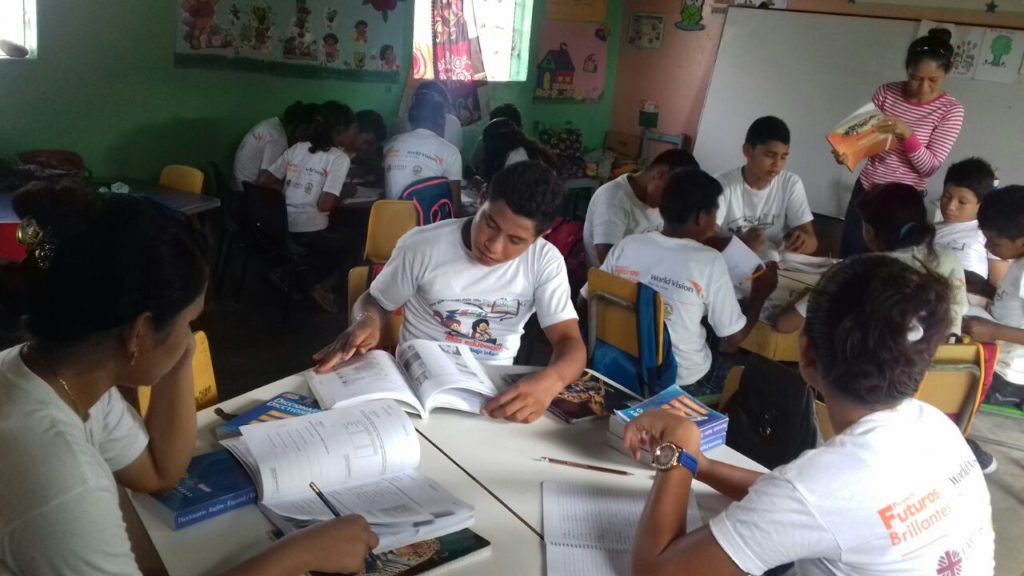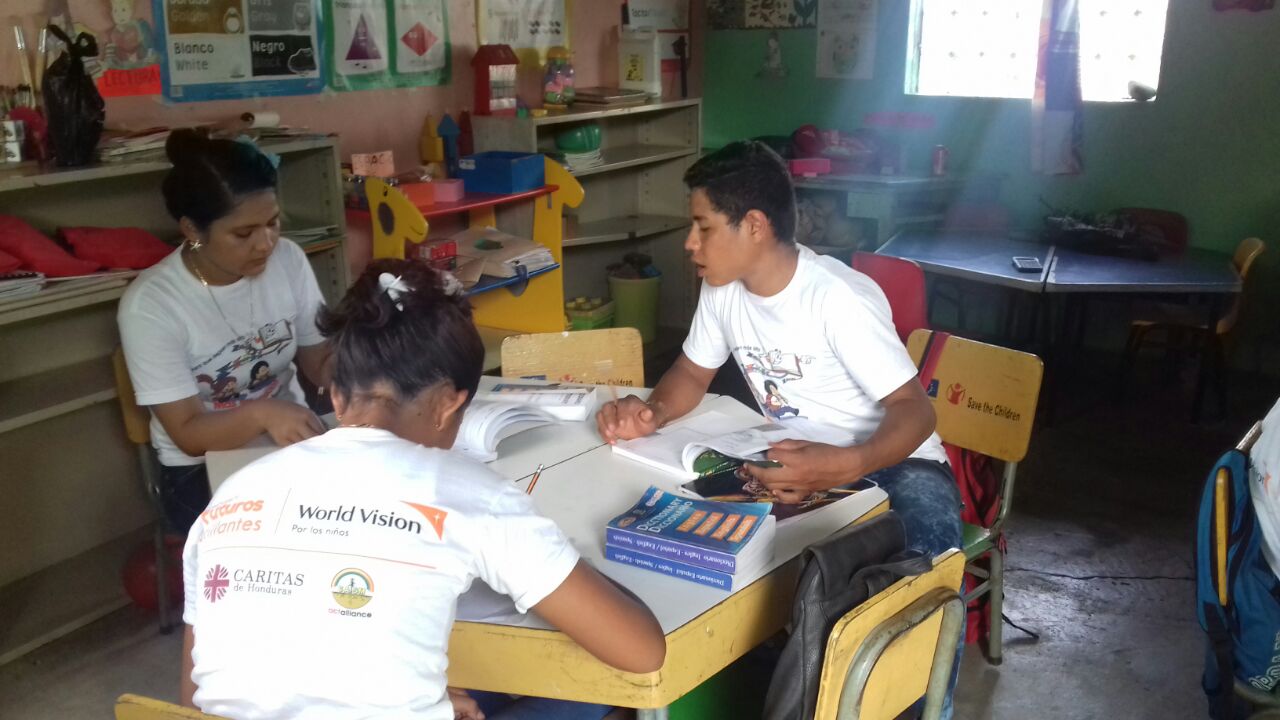By Danielle Crooks, Program Manager, Child Protection and Education, World Vision U.S.
In a community where access to education ends after 6th grade, 15-year old Marlon attends an alternative education program to continue his studies and pursue his dreams.
In Valle, Honduras, Marlon lives with his parents and niece. His father works in agriculture, harvesting corn, and sells charcoal. His mother tends to the house cooking, cleaning and caring for their grandchild.
Due to few job opportunities that pay well in the area, when Marlon turned 14 he was encouraged by his family to get a job. He worked in a nearby salt mine where he scraped and lifted heavy mounds of salt daily. Little did Marlon know he was engaging in one of the most hazardous forms of child labor.
“Child labor” refers to work that deprives a child of their childhood. It is work that is mentally, physically or morally harmful to children and it interferes with their ability to attend school. Mining, specifically, is considered one of the worst forms of hazardous child labor. Working in the salt mines can cause fatigue, dizziness, exhaustion and injuries for children who are using equipment meant for adults. With no protective equipment or shoes on, Marlon used to work in these areas handling salt, a corrosive agent, which cracked the soles of his feet and his hands, sometimes causing blisters.
In 2015, the Futuros Brillantes project, a grant funded by the U.S. Department of Labor and implemented by World Vision, entered Marlon’s community. With the goal to reduce child labor and improve labor rights, the project has served children and families across the country, in nine municipalities, for the past three years.
Futuros Brillantes: A bright future free of child labor
Futuros Brillantes translated into English means bright futures. The name alone brings hope to children and families in Honduras. The three major components to the strategy are supporting education services, providing livelihood assistance and reducing the acceptability of child labor.
Education services provided by the project range from teacher trainings and peer tutoring to alternative education programs for out-of-school youth. So far, 260 teachers have been trained on proven approaches to increase learning in the classroom. 1,426 children have participated in World Vision’s peer tutoring program that supports students struggling academically in primary school to improve their grades. As an additional incentive to stay in school, children from low-income families receive backpacks, notebooks, uniforms and other school supplies. 2,200 children received school kits at the start of the school year.
For older children, 14-17 years of age, who may have fallen behind in their studies or do not have access to secondary school, they can attend an alternative education program and/or a technical vocational program. There are over 28 alternative education programs operating in the project area. Receiving the same standard curriculum as those in public schools, youth like Marlon are able to continue their studies based on flexible school hours and age-appropriate approaches that are conducive to learning.

Attending school or an alternative education/vocational program equips children and youth with the skills and knowledge needed for life as an adult. However, many families in impoverished areas suffer from dire economic restraints and are dependent upon children’s contribution to a household’s income. For this reason, Futuros Brillantes not only provides education assistance but also livelihood assistance to families.
In terms of livelihood services, the project offers financial literacy courses through a World Vision curriculum entitled Entrelazos. Once households graduate from the course, they have the opportunity to pursue an entrepreneurial micro-business, where startup costs are covered by the project. The intention behind the micro-business is that it would generate additional income for the family to supplement whatever earnings a child would have made if working. The project also links these households to savings groups, that have also been strengthened by the project, to then offer access to micro-loans to grow their businesses.
Alongside the education and livelihood activities, the project has several community-level awareness raising efforts to combat the social norms around child labor. While many parents know that the Honduran labor law prohibits children below 14 years of age from working in hazardous labor conditions, very few will abide by it because they see work for a child as an attractive alternative to completing basic education (through 9th grade), claiming that it refines a child’s life skills, their work ethic and keeps them out of trouble.
To counter these sentiments, Futuros Brillantes has worked with the Ministry of Labor and employers to enforce the law prohibiting children from participating in hazardous working conditions. At the community level, the project formed Child Labor Committees (CLCs) – a group of community members (teachers and parents) trained by the project to engage and inform families on the importance of education and the risks of, and alternatives to, child labor. In cases where families need assistance, the CLC reports up and the project intervenes. The CLCs also monitor and provide positive pressure on families to keep their children in school. Overtime, CLCs have become leaders within their communities.
“After the [house] visits, the parents have become vigilant and defend the rights of the children,” said one CLC member. “No more children in the brickyards or selling on the streets.” Several CLCs are now looking at other ways to improve their communities as it relates to health and child protection.
In Marlon’s community, 29 children (13 girls and 16 boys) from 21 families are being supported through a combination of education services, livelihood assistance and awareness raising. Out of the 14 children who were engaged in child labor at the start of the project, nine have been removed from dangerous working conditions, including Marlon.
On Fridays and Saturdays, Marlon attends alternative education classes regularly with other youth. His cohort will be the first to graduate from the program. Marlon recently found decent employment that allows him to still support his family but does not endanger him or take him away from his classes. His hope is to continue his studies at a local institute.
The fight against child labor
Since 2000, there are 94 million fewer children working in child labor. It takes children, teachers, parents, community members, organizations like World Vision, and governments like the United States to achieve progress for children.
The Department of Labor’s International Labor Affairs Bureau plays a critical role in the fight to end child labor. Unfortunately, the Administration has proposed completely cutting their grant program, which funds community-based anti-child labor programs like Futuros Brilliantes.
ACT NOW
Ask Congress to keep fighting child labor!
Top photo: In Valle, Honduras, Marlon begins his alternative education class. ©2018 World Vision/photo by Elmer Osorto, Project Facilitator.



This is an excellent project! I am really impressed by the holistic work that Workd Vision is doing to end the cycle of child labor.
Thank you for all your amazing hard work!